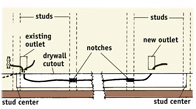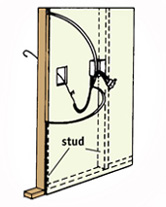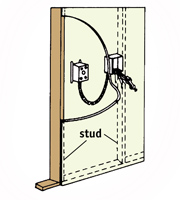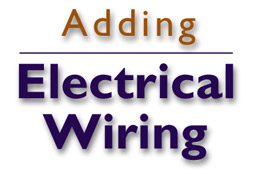|

FIG. 12 - New cable
can be run along the baseboard to a new outlet.

FIG. 13 - Cut an opening
in the wall opposite the existing box.

FIG. 14 - If the new
box is not near a stud, it can be held in place by box supports.
|

ADDING NEW WIRING ON THE SAME WALL
- You can connect new cable from an existing outlet to a new outlet on the
same wall by running it inside the wall (Fig. 12). Mark the approximate
location of the new outlet. Using a stud finder locate and mark the
wall studs. Start one stud before the existing outlet and end one stud
after the new outlet.
- Mark the exact location of the new box. Make it the same height as the
existing box. Do not locate it over a stud. Using a drywall or keyhole
saw, cut the opening for the new box.
- Using a utility knife and a drywall saw, cut a strip of drywall about 3"
wide out of the wall, below the outlets. Start at the center of the
first stud you marked and end at the center of the last stud; watch
for nails as you cut. Carefully remove the drywall strip.
- Using a hand or circular saw, make two cuts 1" apart and 3/4"
deep in each of the exposed studs. Using a hammer and a chisel, remove
the wood between the two saw cuts.
- Be sure the power is off to the existing outlet. Remove the cover
plate and the receptacle. Remove one of the knockouts in the bottom
of the box. Run the new wire behind the wall and up through the knockout
in the box. Tighten the clamp and attach the wires. If the box does
not have a clamp, place a wire clamp on the new cable. Tighten the screw
to hold the clamp on the wire. Be sure the nut is off the wire clamp
and run the wire up to the box as before. Feed the threaded end of the
clamp up through the knockout, replace the nut and tighten. Replace
the receptacle and the cover plate.
- On the new box, remove one of the knockouts in the bottom of the box. If
the box you are using is a self-clamping box, insert the box into the
wall and tighten. If not, insert the box into the wall, insert a Madison
hanger on each side of the box, and bend the tabs over into the box
to tighten.
- Finish running the wire from the existing box through the notches and up
behind the wall into the box as before. Clamp the wire and install the
receptacle as in Fig. 3. Install the cover plate, turn on the power,
and test the circuit with a neon tester. Shut off the power again to
safely finish the project.
- Nail metal cable protectors to the exposed studs over the notches. Replace
the drywall strip you removed earlier. Use the spackling compound and
drywall tape to complete the installation.
- Cable can be pulled from an existing box on one wall to a new outlet on
the opposite side of the same wall (Fig. 13).
- Attach a cable to the existing receptacle in the box as previously
described. Allow ample slack in the cable to permit easy connection
to the new box to be installed on the opposite wall.
- Bring the cable through the new opening with a wire, as illustrated in
Fig. 13.
- Connect the cable to the new box, attach the desired receptacle, and mount the box to the wall with box supports if it is not near a stud (Fig. 14).
|















